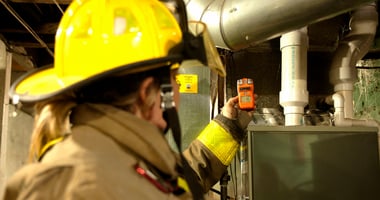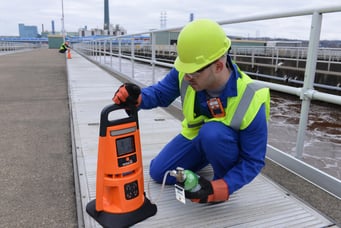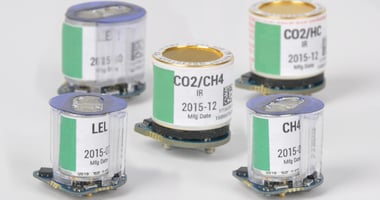Dropping temperatures outside mean furnaces and wood burners are heating up inside, putting homeowners and first responders at a higher risk for carbon monoxide poisoning.
Carbon monoxide isn’t a naturally occurring gas, but it’s one people are the most likely to encounter. With more than 50,000 people hospitalized each year for carbon monoxide poisoning, it’s important for fire departments and first responders to know what to look for when responding to a carbon monoxide call.
Dangerous levels of carbon monoxide can be produced by any fuel-burning appliance, including gas furnaces, gas stoves, gas dryers, gas water heaters, fireplaces, and cars. Many furnaces and ovens produce large amounts of carbon monoxide, especially when they are not maintained properly. Truck drivers, forklift operators, or people working near this type of equipment are at a higher risk of exposure, as are people who work in confined spaces such as manholes, garages, tunnels, loading docks, warehouses, vehicle repair shops, and splicing vehicles.
Carbon monoxide is an insidious toxin that seems tailor-made to fool the unsuspecting. Colorless and odorless, it’s impossible to detect without gas monitors. To make matters worse, carbon monoxide poisoning is easily mistaken for the flu because they share many of the same symptoms, including nausea, headache, and fatigue. The risk of carbon monoxide poisoning is also greatest during flu season, making it even harder to identify. But identify it you must: if carbon monoxide is present, you need to immediately evacuate the area.
Follow these steps to complete a thorough and systematic carbon monoxide investigation:
1. Interview the Occupants: Talk to the occupants and look for symptoms of carbon monoxide exposure. Ask about possible sources of combustion.
2. Measure for Carbon Monoxide: Do not enter the area to locate potential carbon monoxide sources without a functioning gas detector and proper PPE. Check for possible sources of carbon monoxide by using a properly-calibrated carbon monoxide gas detector. Be sure to zero the monitor in fresh air before arriving at the scene. Compare your readings with the levels below:
- 50 PPM: Permissible Exposure Level (PEL) for 8 hours (OSHA)
- 200 PPM: Possible mild frontal headache in 2 to 3 hours.
- 400 PPM: Short-Term Exposure Limit (STEL) for 15 minutes (ACGIH)
- 800 PPM: Headache, dizziness, and nausea in 45 minutes; collapse and possible death in 2 hours
- 1,500 PPM: Immediately Dangerous to Life and Health (IDLH) in 30 minutes (OSHA)
3. Inspect Venting Systems: Check all chimneys and all other appliance venting systems for leaks, cracks, holes, and blockages.
4. Create a Worst-Case Scenario: Turn on all fuel burning appliances simultaneously and close up the house. If the house builds up negative pressure, a backflow condition may occur. To check for this condition, turn on all exhaust devices (attic fan, kitchen vent hood, bathroom fans, etc.) and use a smoke generator to test backflow from the fireplace, hot water tank, and furnace.
5. Check Carbon Monoxide Alarm Location and Serviceability: Ensure the home carbon monoxide monitors are functioning. Check that they are installed according to the manufacturer’s recommendations and that they are not located in hot areas, humid areas, or within at least 15 feet of a fuel-burning appliance.
You may have responded to more false alarms than true carbon monoxide emergencies in your career, but that’s not a reason to let down your guard.
To help protect yourself, keep these life-saving tips in mind:
- Bump test your gas detector before each use
- Calibrate your gas detector at least monthly or as recommended by your safety team
- Only zero the gas detector in fresh air or with zero air
- Know how long to wait for your gas detector to provide an accurate reading
- Understand all alarms and signals for your gas detector
- Never ignore a warning from your gas detector
Treat every carbon monoxide call like your life depends on it – because it does.



